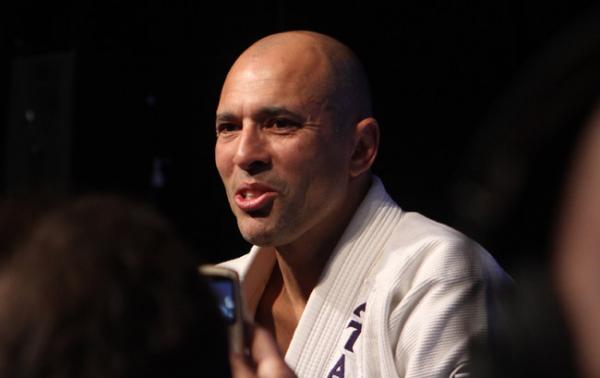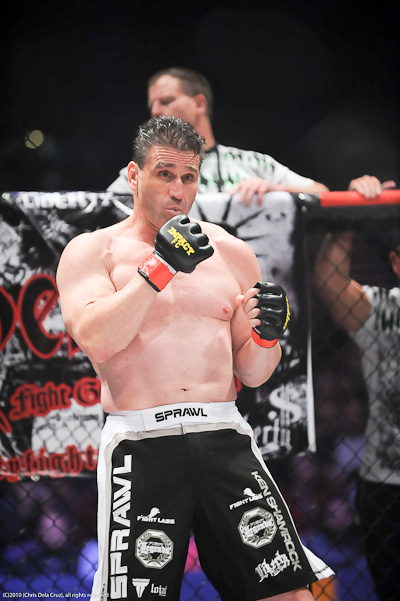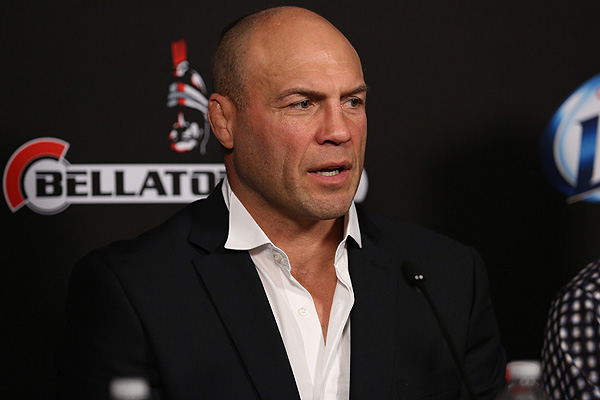Migration of Legends

Royce Gracie joined Bellator as a brand ambassador in October. |
Photo: Marcelo Alonso/Sherdog.com
From Ken Shamrock, Royce Gracie and Frank Shamrock to Tito Ortiz, Randy Couture and Quinton Jackson, there has been a noticeable trend among many of MMA’s all-time greats over a series of years. One after another, stars who main evented major Ultimate Fighting Championship events have left the sport’s top promotion and become affiliated with the rising Bellator MMA organization. Nearly half the men who comprise the UFC Hall of Fame will be participating in functions in conjunction with Bellator 131 on Saturday in San Diego. Wanderlei Silva was the latest iconic figure announced to join in the ceremonies surrounding the show before being pulled due to UFC contractual obligations.
The circumstances behind the movement of different fighters have been markedly varied. Some have engaged in a public war of words with the UFC and relished the opportunity to stick it to their former company, while others have left on good terms and gone out of their way to emphasize that there is no hostility on their part. Some have joined Bellator looking for fights that were no longer available to them in the UFC, while others have simply involved themselves in public relations work. Regardless of the nature of the individual moves, there has been a decided overall trend, which is likely to shape both the UFC and Bellator in the years to come.
Advertisement
“The problem is there is no one really there to handle the ex-athletes,” Ken Shamrock said. “It’s important for these athletes to be involved in the stuff they helped to create. They’re there for the fans, who love to see the guys they used to watch. It makes those fans feel young again. That’s good for everyone. You have all these smart business guys, yet they can’t find the simplest things that make people happy, and that’s being around people that make them happy. It builds the young guys who don’t have a face yet [and] who can rub shoulders with those who already did it.”
Shamrock’s insight is simple but often overlooked: Fans enjoy
seeing their heroes even if they are no longer active. The value of
older fighters is often seen through the prism of what they have
left in competition and what younger fighters can gain by beating
them -- for example, Gracie elevates Matt Hughes,
who then elevates Georges St.
Pierre. However, if used properly, those fighters can help
foster a lasting relationship with fans long after their fighting
careers are done.
While the potential is there for retired fighters to play a major role in helping to build the sport going forward, there is no guarantee they will. The question is whether MMA will be a sport more like baseball, where history is celebrated, or a sport more like football, where history tends to be forgotten. If MMA’s legends gradually become forgotten, there is limited value for promotions that might want to use them. However, if MMA promotions can keep them in the public imagination, the two sides can mutually benefit over time. In that sense, Bellator’s investment in these older fighters is ultimately an attempted investment in itself.
Bellator’s attempts to utilize older fighters began under former CEO Bjorn Rebney. Bellator’s “Fight Master” reality show featured legends Frank Shamrock and Couture as coaches when many expected a greater focus on active Bellator stars. That approach has been expanded under current Bellator President Scott Coker.
“If not for Scott, I would not be here,” Royce Gracie said. “He’s the reason. I knew him before and he was already one of the best. We had a relationship before he became president, and I look forward to working with him again.”
There are downsides to showcasing so many older fighters. Bellator does not want to be perceived as a landing spot for washed-up talent. If that becomes the perception among fans, wins by those fighters seem less impressive and it becomes harder to make their fights feel relevant. Bellator wants a fight like Alexander Shlemenko-Ortiz to be viewed as confirmation that Ortiz still is a dangerous fighter, not that Shlemenko lacked the goods to begin with. Negative presumptions are difficult to overcome.
In that regard, Bellator is in a somewhat better position to showcase aging stars than the UFC. Older stars tend to retain their television ratings drawing power longer than their pay-per-view drawing power, and Bellator is much more television-based than the pay-per-view-oriented UFC. The Bellator 131 main event between Ortiz and Stephan Bonnar will be a test of that, as this is Ortiz’s first free television fight since 2006, when his fight with Ken Shamrock drew some of the highest viewership numbers in the history of American MMA. Ortiz has the opportunity to prove he still has juice as a television attraction.
Beyond the impact these legends can potentially have for Bellator, there is also the question of what relevance these moves have for the UFC and what they say about that organization. For years, high-profile fighters have gotten into public squabbles with UFC President Dana White and the company he leads. When these disputes involved controversial and outspoken figures like Ken Shamrock and Ortiz, it was easier for many to dismiss their criticisms. That is not the case when it comes to beloved figures like Couture or the more recent disagreements between White and St. Pierre. It does the UFC’s public goodwill no good to have a cadre of disillusioned stars throwing their hat in with the opposition. What’s more: In a lot of cases, the disputes are over relatively minor concerns.
“At least in my experience, there was no communication,” Ken Shamrock said. “They’d thank you and then disappear, and then you feel like you’re being disrespected. How do you not invite me to a show? It seems silly, but you’ve got to remember these guys carry the show and then all of a sudden they’re gone and nobody cares about them, except the fans. When they don’t invite you to be a part of that, it hurts. There’s disrespect in the media saying we’re used up. Even if a guy goes out and talks smack because they’re high-strung and believe they can fight, you don’t have to challenge them. Don’t be that person. It hurts to be pushed away from something you helped build.”
While a little consideration can go a long way, there is ultimately only so much investment any MMA company can make in retired stars. Most fighters would love a high-paying job behind the scenes, but as Bonnar notes, “It’s hard for both of them. There are so many legends of the sport and guys who helped start it, and it’s not like UFC can use everyone. It’s tough.”
What’s more, finding jobs for select fighters can backfire. For every Chuck Liddell or Hughes given a job behind the scenes, resentment rises with other fighters who wonder why they are not given the same treatment. Even well-intentioned moves can have unexpected blowback. This will become even more of a pronounced issue over time, with an expanded roster full of fighters who feel they played an important role in the growth of the sport.
If there is one figure that stands at the center of the issue now and going forward, it is White. He has the power to keep those he wants under the UFC banner and to jettison those he dislikes. Fighters on his bad side often cite him as the reason for their falling out with the UFC, while fighters on his good side seek his approval before joining other companies.
If the UFC has an interest in keeping a host of retired legends around its organization and in preventing Bellator from utilizing them, it might behoove the company to use someone else, perhaps a respected ex-fighter, to serve as a liaison between the UFC and its former greats. White’s outspoken style is well-suited to shaping public opinion and selling fights, as well as keeping active fighters in check. However, when it comes to fighters who have accomplished so much and to whom pride is of paramount importance, a softer touch might be beneficial. That is certainly how many aggrieved parties feel.
“It was either Dana’s way or no way,” said Ortiz, a longtime nemesis of White. “It was an old gangster mentality. Fighters get sick of it. You put up with it, put up with it, and eventually you say, “Enough’s enough” -- like Wanderlei Silva. It would be better if there was someone who treated the fighters with more respect.”
Regardless of who is most to blame for dissolved relationships and what can be done to prevent those sorts of splits in the future, the operative question in the short term is what will come of the gravitation of so many stars towards Bellator. Will those legends help Bellator grow, or will they simply add to the payroll while creating the perception of a promotion behind the times? Coker is betting on the former, and MMA fans will dictate whether this promotional strategy proves to be a lasting one.
Related Articles










